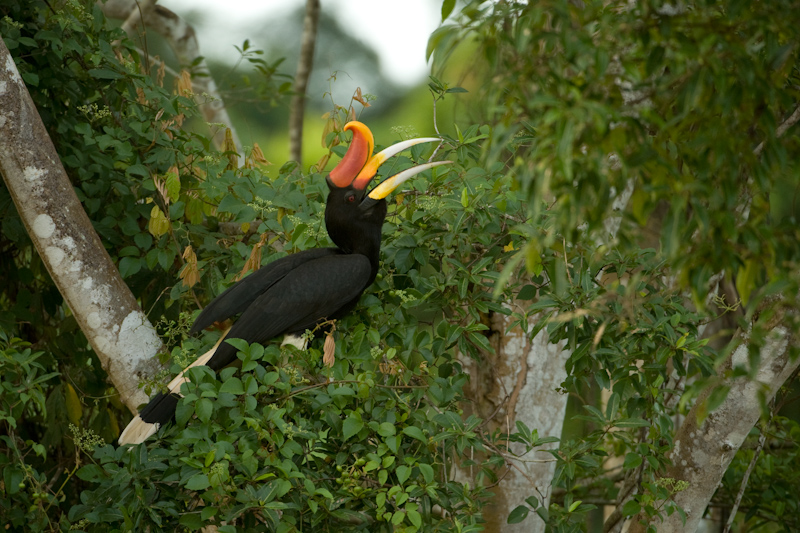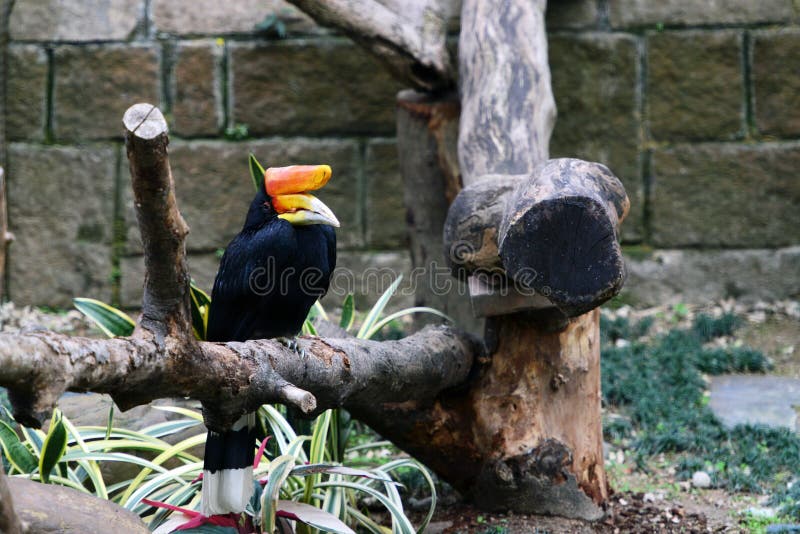

Hornbills are important for seed dispersal and help spread the food they eat.

Only four species have ever been observed drinking. They get all the water need from their food. Some have to ability to clasp fruit, insects and other food with the tip of their bill and deftly toss it in the air and catch it their gullet like a person catching a piece of popcorn in their mouth. Many species collect fruit in their neck pouch and hide them in caches. Hornbills primarily feed on fruit, figs and insects. Males are slightly larger than females but females are more courageous, choosing to fight monitor lizards and snakes that males back off from. A few species form groups whose goals are to defend the group territory and help a dominant pair breed. Copulation usually tales place during the last phase of nest building. Pairs usually share and defend a territory that ranges in size from 10 hectares to 100 square kilometers.

On the Indonesian island of Sumba, they are symbols of fidelity. The largest hornbill, the five-kilogram south ground hornbill, produces a booming deep bass call that can be heard 2½ miles away. Some species produce exaggerated displays while calling. Helmeted hornbills of Malaysia produce noises that sound like hooting and laughter. Each species has its own distinctive calls. Sometimes the savannah dwellers migrate during the wet and dry seasons. Sometimes the forest dwellers fly beyond their territories to search for fruit. Most of those that live in Asia dwell in the forests. All the species save one that live in Africa live in savannahs and grasslands. Most hornbills are sedentary and live in defined territories. The wing beats of some species can be heard a half mile away. Large hornbills lack feather that allow for smooth air flow. The loud whooshing noise emanating from some large hornbills as they fly is produced by gaps in the hornbill’s wing feathers and air being compressed in these gaps. Some species have white feathers that give them distinctive markings. The feathers of hornbills or mostly black, gray or brown. They have strong claws which allow then to grip the sides of trees like woodpeckers.
#RHINOCEROS HORNBILL SYMBOL SKIN#
The throat skin may form wattles, or inflation sacs. Their eyes are often brightly colors with greens, reds, yellows and blues.

Hornbills have bare facial skin and long eyelashes. These features stiffen and strengthen the neck, give power to the bill and turn the head into a kind of pick axe Hornbills have strong neck muscles that support the head and two fused vertebrae in the neck, a feature unique among birds. The shape of the casque is often the easiest way to determine species. The casque of helmeted hornbill it is a block of solid ivory and helps make the skull 11 percent of its body weight. In many species it has been modified into a hollow resonator. But may also play a role is sexual selection and amplify the bird’s calls. The casque seems to serve primarily as a reinforcing ridge along the top of the bill. Bill development is often an indicator of sex and age. The bill is an integral part if the hornbill’s skull and is used by the bird to feed, fight, preen, make nests and keep snakes from attacking the vulnerable parts of their body. Hornbill have long curving bills that are mostly yellow and can reach lengths of 13 inches. Other are taken by poachers who can sell the chicks of arre species of up to $1,000 a piece. Some have fallen prey to poisons left out for other animals. Many hornbills are endangered or threatened as a result of deforestation, loss of habitat and hunting for their bills, feathers and meat. Many large ones have horn-like casques on their bill. The largest hornbill are the size of turkeys. Toucans are regarded as their New World equivalent. Hornbills are found only in the Old World. In western Borneo, a celebration honoring hornbills is held every five to seven years. Borneo hill tribes regard rhinoceros hornbills as deliver of souls to the afterlife. They are found in many myths of tribes on Southeast Asia and Indonesia. Hornbills first appeared in the fossil record about 15 million years ago. Only four species are found east of the Wallace Line. There are 54 species of hornbill: 23 species living in the savannahs and forest of Africa and 31 species in Asia, living mostly in tropical rain forests. Hornbills are a kind of bird named after their the large horn-like bills found on most species.


 0 kommentar(er)
0 kommentar(er)
